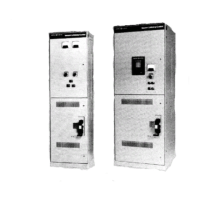CR194 Two-High Vacuum Limitamp@ Control
in size and rating so are not interchangeable. Figure 5
shows the CR194 two-high stationary contactor. Figure
6 shows the CR194 two-high drawout contactor. The
400 ampere stationary contactors in the two-high
vacuum Limitamp@ and 26”-wide & 34”-wide stationary
vacuum Limitamp@ are the same basic contactor, but
are not directly interchangeable since the auxiliary
interlocks and wire harness are mounted differently
on the contactors, and the two-high stationary
contactor is mounted on a slide base. To use a 26”-
wide or 34”-wide 400 ampere stationary contactor in a
400 ampere two-high stationary enclosure, the auxil-
iary interlocks 8c wire harness should be removed frorr
the contactor, and the two-high auxiliary interlocks,
wire harness & slide base mounted on the contactor.
The same procedure but in reverse would be required
to use a two-high stationary contactor in a 26” or 34”-
wide stationary enclosure.
The stationary contactor is easily removed from the
controller by disconnecting the line and load power
LINE CABLE
SLIDE BASE
Figure 5.
CR194 two-high stationary contactor showing
auxiliary interlocks, wire harness, line cable and slide base
connections and sliding the contactor out. The auxiliary
contacts are electrically connected by means of a remov-
able umbilical cord plug that is retained by two wing
nuts. By removing these wing nuts, the wiring harness is
easily disconnected from the contactor. The drawout
contactor is removed in a similar manner by first remov-
ing the Positioning Bolts then sliding the contactor out.
Refer to the section titled “Contactor Removal” that
details these procedures.
The contactor is magnetically operated by a DC coil
fed by a rectifier and timed holding circuit. The base
mounted contactor timing module (CTM) shown in
Figure 7 applies full voltage to the contactor for a time
sufficient to fully close the contactor. Then it inserts a
capacitor into the circuit to hold the contactor closed
at a reduced voltage to prevent overheating the coil
and provide for fast dropout when power is removed.
6
Figure 6. Rear view of CR194 two-high drawout contactor
showing stab connectors.
- (CTM) W
TERMINAL 1
BOARD (TB)
E
:
H(
figure 7. View of low-voltage compartment showing
contactor timing module (CTM) , test-normal selector
switch (TSW) and terminal board (TB)
Manual Disconnect (Isolation Switch)
CR194 two-high vacuum Limitamp@ controllers, follow-
ing the NEMA definition, provide a means for manu-
ally isolating the high-voltage power circuit by opera-
tion of a disconnecting device. Each starter cubicle
(upper & lower) has its own disconnecting mecha-
nism, which consists of a quick-make, quick-break,
non-load break isolation switch (see Figures 8-l 1)
which is controlled by an operating handle (see Figure
4). A fixed barrier (Figures 10 and 11) with a viewing
window is supplied to provide isolation from the
energized bus parts.
NOTE:
The quick-make, quick-break isolation switch will not
interrupt any load or fault current.
The isolation switch handle will accept up to four pad-
locks to prevent operation. See Figure 12.

